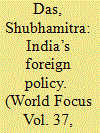| Srl | Item |
| 1 |
ID:
067966


|
|
|
|
|
| Publication |
New Delhi, National Book Organisation, 2005.
|
| Description |
xii, 163p.
|
| Standard Number |
8187521163
|
|
|
|
|
|
|
|
|
|
|
|
Copies: C:1/I:0,R:0,Q:0
Circulation
| Accession# | Call# | Current Location | Status | Policy | Location |
| 050859 | 355.033594/DAS 050859 | Main | On Shelf | General | |
|
|
|
|
| 2 |
ID:
191837


|
|
|
| 3 |
ID:
148107


|
|
|
|
|
| Summary/Abstract |
India’s foreign policy in the 21st Century is appraised due to the interplay of geoeconomics with geopolitics and India’s search for a visible and a constructive role on the global map, the need for sustainable economic growth, energy security, food security and border disputes on the one hand and the United States’ Pivoting Asia and expecting India to take the lead role on the Indian Ocean. Therefore the core policy paradigm Nonaligned Movement (NAM) has come into strict scrutiny. The paper will deal with Non-aligned Movement from three angles a) NAM being the central factor in India’s foreign policy making, b) India’s role in NAM, c) NAM and Indo-US relation.
|
|
|
|
|
|
|
|
|
|
|
|
|
|
|
|
| 4 |
ID:
183144


|
|
|
|
|
| Summary/Abstract |
Indo-Pacific has emerged as a region of great movement, conflict and cooperation, contestations and coalition-building. The emergence of minilateral and multilateral cooperation by the middle powers is increasing in the region, with the regional countries enthusiastically mapping the region focussing on their centrality. History proves that the role of middle-power countries became more prominent during the moments of international transition. The two contrasting powers like India and Australia; one with a post-colonial identity in foreign policy-making, subtle emphasis on non-aligned movement (NAM) and emerging as an influential power, and, on the other, a traditional middle power with an alliance structure and regionalism akin to the Western model, have equal stakes in the region and it is inevitable for them to take a leadership position in building what is called a middle power communion in the Indo-Pacific. This article will explore the understanding of middle powers and how India and Australia, as middle powers; are strategically placed and, being great powers within their respective regions; take the responsibility of region-building and maintaining peace with great powers, and how the Indo-Pacific and Quad are emerging as discourses within their foreign policy-making.
|
|
|
|
|
|
|
|
|
|
|
|
|
|
|
|